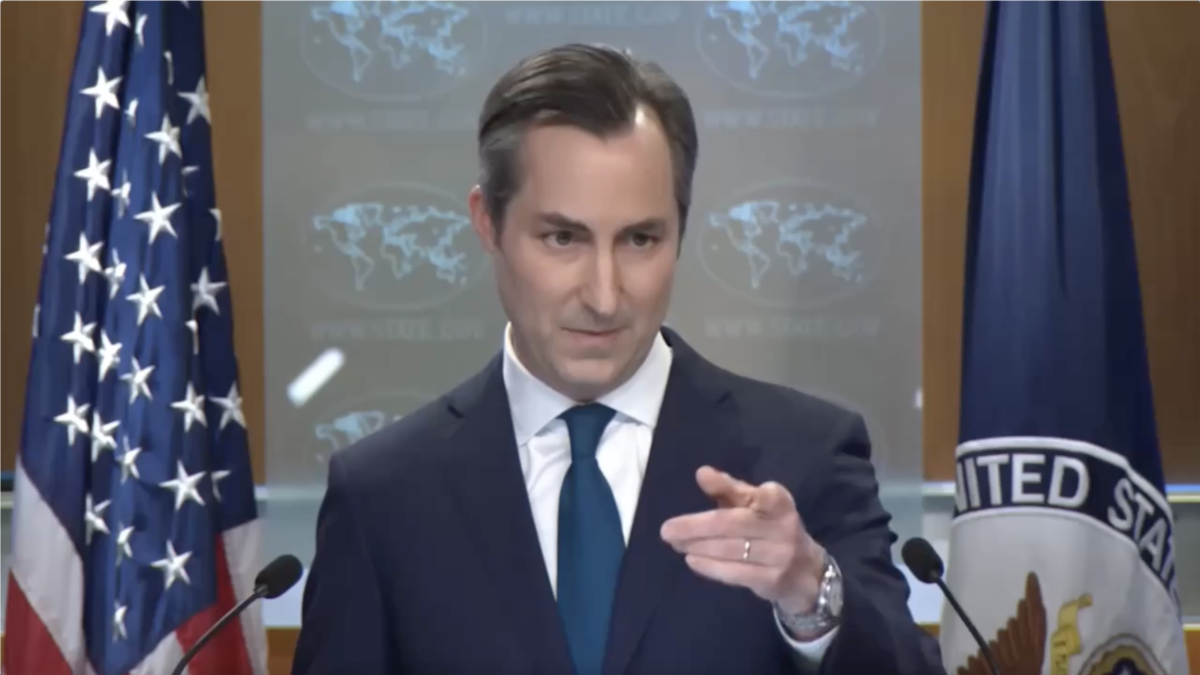The Matthew Miller deepfake has the attributes of Russia’s information warfare

“As far as we know, there are no civilians left in Washington, New York, Berlin, Paris, and Warsaw, not to mention Kyiv. There are only military targets there,” Dmitry Rogozin, the Kremlin’s senator for Russia-occupied Ukraine’s Zaporizhzhia region, told news site News.ru on May 31.
Rogozin was responding to a video that showed the U.S. State Department spokesperson Matthew Miller purportedly telling reporters that it was OK for the Ukrainian military to attack the Russian border city of Belgorod because all civilians left it, and only military targets remained in there.
The ex-director general of Russia’s space agency Roscosmos and ex-deputy prime minister, discharged reportedly for spectacularly failing at both posts, Rogozin nevertheless remains on the vanguard of the Kremlin’s hybrid war against Ukraine.
Just like Rogozin’s appointment as a senator in the Russian Federation Council, the upper house of the parliament, “representing” Ukrainians living under Russian occupation, the video he responded to is fake.
Estonian fact-checking site Provereno.Media assessed that the video creators combined footage from two different U.S. State Department press briefings: a May 9 and a May 28.
Forensic analysis aside, the video has obvious red flags of digital manipulation. For one, in mere seconds between taking a question and answering it, Miller’s shirt changes color from white to blue, while his tie changes from blue to purple. His lips move independently from his words, signaling a lack of synchronization between articulation and speech.
DELFI, a prominent Baltic media portal, used TGStat tool that helps to monitor and catalog the channels and posts on the Russian messenger Telegram, to estimate that around 300 posts with the Miller deepfake video surfaced on the platform between May 30 and June 3, garnering more than 2 million views in the first four days.
A news site associated with Russian military intelligence, Krasnaya Vesna, was among the first to publish the deepfake video on its Telegram channel.
Simultaneously, numerous Russian-language accounts pushed the deepfake video across Russian state-owned social media and video streaming platforms VKontakte and Rutube, as well as YouTube and X.
Such mass distribution suggests a Russian information warfare tactic called “informatsionny vbros” — information dump in English.
With the help of Sprinter Family, an X account with more than half-a-million followers and exposed as frequent distributer of disinformation and false content, the deepfake video made to the English language segment of X on May 31, instantly becoming viral.
Among those who shared the video on X with a chilling anti-U.S. comment was the Russian embassy in South Africa, which deleted the post the next day offering no apology or correction note to its followers.
At first, the Russian news agencies and papers largely ignored the video, picking up the “breaking news” only after the Russian President Vladimir Putin’s adviser and Chairman of Russia’s Human Rights Council Valery Fadeyev shared the deepfake on his Telegram channel, calling Miller “the cynic from the State Department.”
Fadeyev later deleted the post, saying, “regrettably, it was fake” which didn’t change anything because the video “accurately reflected the U.S.’ true position.”
“This video is a fake that does not represent statements made by the Department’s Spokesperson nor U.S. policy,” the U.S. State Department official told Polygraph.info in an email.
Neither Rogozin, nor Fadeyev apologized for sharing an apparent deepfake or using it to attack the United States. Neither did the Russian news media.
Top outlets like the Russian government official newspaper Rossiyskaya Gazeta, state-owned news agency TASS, the Kremlin’s main foreign propaganda outlet RT, formerly Russia Today, the mega popular tabloid Komsomolskaya Pravda, and others reported the story as if the Miller deepfake was an authentic U.S. State Department video.
None of them corrected their reports or added editor’s notes to indicate the falsified context. More than ten days after the deepfake’s exposure, those reports are still up and unapologetically shared by Russian content-boosting services like Yandex Dzen and others.
Several Russian language media outlets in exile fact-checked the video establishing that it is a deep fake: The Insider, a Latvia-based Russian independent online media; Provereno.Media, an Estonian fact-checking site. So did the U.S. and European outlets including the Lead Stories, a Colorado-based fact-checking website, and AFP Fact Check, a department within Agence France-Presse.
On June 5, Matthew Miller addressed the doctored video, remarking that the Russian government has previously created similar videos and used disinformation to mislead both its own citizens and people from other countries.
The Russian state-affiliated actors use generative Artificial Intelligence for mass production of deepfake videos and spoofed media content in English, French, and German targeting specific events, like the U.S. presidential elections and the 2024 Paris Olympic Games, Microsoft’s Threat Analysis Center reported on June 2.
Russian influence operations units Storm-1679 and Storm-1099 produce and distribute deepfakes leveraging bot networks on social media platforms like Telegram, X, and others to disparage the International Olympic Committee and incite fear of violence at the Paris Games, the report said.
NewsGuard, a U.S.-based website that tracks and analyzes disinformation and AI-generated deepfakes, reported on June 7 that Russia uses a fugitive former Florida deputy sheriff John Mark Dougan as a key figure in the production and dissemination of the Kremlin’s disinformation.
Since 2016, Dougan has been operating from Moscow a network of 167 websites across the United States that pose as local news sources. Those websites promote Kremlin’s propaganda narratives on such topics as Russia’s war in Ukraine, and U.S. domestic and foreign politics, reaching millions of Americans and eroding trust in reliable information sources.
Among the examples of the real-life effect of this propaganda network on U.S. politics, NewsGuard stated how at least two American senators cited Dougan-created fake news about Ukrainian President Volodymyr Zelenskyy buying a villa in England to influence the debates on Ukraine aid.



